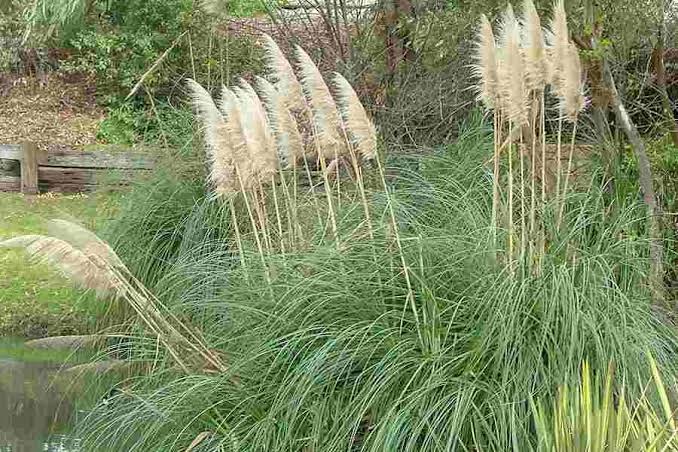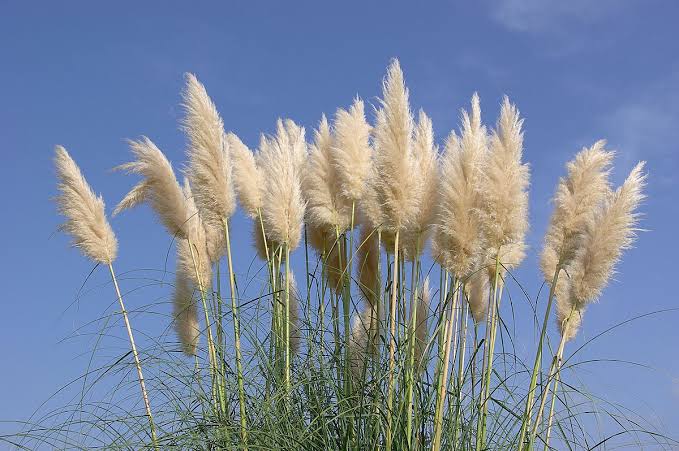Uruguayan pampas grass (Cortaderia selloana) is a tall, graceful plant that is native to Uruguay. This remarkable grass is known for its feathery plumes and distinctive appearance, making it a captivating addition to landscapes around the world.
The Uruguayan pampas grass is characterized by its long, slender blades that gracefully sway in the breeze. These blades can reach impressive heights, creating a stunning visual effect as they gently rustle in the wind. The plant’s scientific name, Cortaderia selloana, reflects its unique features and origin.
One of the remarkable attributes of this grass is its adaptability to various soil types and climates. Whether in gardens, parks, or natural habitats, Uruguayan pampas grass can thrive in different environments, showcasing its versatility and resilience. Its ability to withstand diverse conditions has contributed to its popularity among gardeners and landscapers.
During the flowering season, Uruguayan pampas grass produces magnificent plumes that rise above the foliage, adding an ethereal touch to the landscape. These plumes, often creamy white or silver, create a striking contrast against the greenery, enhancing the overall aesthetic appeal of the plant.
Beyond its ornamental value, Cortaderia selloana serves ecological functions as well. Its dense growth provides habitat and shelter for various wildlife, contributing to biodiversity in the regions where it flourishes. Additionally, the grass’s deep roots help prevent soil erosion, showcasing its role in environmental conservation.
Cultivating and caring for Uruguayan pampas grass is relatively straightforward, making it a favorite among garden enthusiasts. Regular pruning helps maintain the plant’s shape and prevents it from becoming overly invasive. Adequate sunlight and well-drained soil are key factors for optimal growth.
Uruguayan pampas grass, scientifically known as Cortaderia selloana, stands as a symbol of elegance and adaptability. With its graceful blades, captivating plumes, and ecological contributions, this grass has rightfully earned its place as a beloved and versatile addition to landscapes worldwide.
Whether swaying in the gentle breeze or providing a haven for wildlife, the beauty and resilience of Uruguayan pampas grass continue to enchant and inspire nature lovers everywhere.
Read Also: How to Grow and Care for Peaches
How To Grow Uruguayan Pampas Grass (Cortaderia selloana)

Growing Uruguayan pampas grass (Cortaderia selloana) can be a rewarding experience, adding elegance to your garden or landscape. Here’s a simple guide on how to cultivate and care for this graceful plant:
1. Choose the Right Location: Select a sunny location with well-drained soil for optimal growth. Ensure that the chosen area receives ample sunlight, as Uruguayan pampas grass thrives in full sun conditions.
2. Planting: Plant the grass in the spring or early summer for the best results. Dig a hole twice the size of the root ball and place the plant, making sure the top of the root ball is level with the soil surface. Space multiple plants several feet apart to allow for proper growth.
3. Soil Preparation: Uruguayan pampas grass is adaptable to different soil types, but it prefers well-draining soil. Add organic matter, such as compost, to improve soil fertility and drainage.
4. Watering: Water the grass regularly, especially during dry periods. While the plant is drought-tolerant once established, consistent watering promotes healthy growth. Be cautious not to overwater, as this grass does not thrive in waterlogged conditions.
5. Pruning: Prune the grass in late winter or early spring to remove old, dead foliage and encourage new growth. Use sharp pruning shears and wear protective clothing, as the grass blades can be sharp. Trim the plumes if desired, but be mindful not to remove too much foliage.
6. Fertilization: Uruguayan pampas grass generally doesn’t require heavy fertilization. Apply a balanced fertilizer in spring to promote healthy growth. Too much nitrogen can result in excessive leafy growth at the expense of plume development.
7. Invasive Control: Keep an eye on the plant’s growth to prevent it from becoming invasive. Uruguayan pampas grass can spread rapidly through its root system. Consider planting it in containers or using barriers to control its expansion.
8. Winter Care: In colder climates, provide winter protection by mulching around the base of the plant. This helps insulate the roots and protects them from extreme cold.
9. Pest and Disease Management: Uruguayan pampas grass is generally resistant to pests and diseases. However, keep an eye out for signs of stress or infestation. Treat any issues promptly with appropriate measures.
By following these simple guidelines, you can successfully grow and care for Uruguayan pampas grass, enjoying its beauty and elegance in your outdoor space.
How To Care For Uruguayan Pampas Grass (Cortaderia selloana)
Caring for Uruguayan pampas grass (Cortaderia selloana) involves a combination of maintenance practices to ensure its health and aesthetic appeal. Here’s a guide on how to care for this graceful plant:
1. Pruning: Trim the grass in late winter or early spring to remove dead or damaged foliage. Use sharp pruning shears and wear protective clothing to avoid the sharp edges of the grass blades. Additionally, you can cut back the plumes if they appear weathered or damaged.
2. Watering: While Uruguayan pampas grass is drought-tolerant once established, it benefits from regular watering, especially during dry spells. Water deeply to encourage deep root growth. Avoid overwatering to prevent waterlogged conditions, which can be detrimental to the plant.
3. Fertilization: Apply a balanced fertilizer in the spring to promote healthy growth. Avoid excessive nitrogen, as it can lead to lush foliage at the expense of plume development. Follow the recommended application rates on the fertilizer packaging.
4. Invasive Control: Monitor the growth of the grass to prevent it from becoming invasive. Consider planting it in containers or using barriers to contain its spread, especially if you’re concerned about it taking over the garden.
5. Winter Protection: In colder climates, provide winter protection by applying a layer of mulch around the base of the plant. This helps insulate the roots and protects them from extreme cold temperatures.
6. Pest and Disease Management: Uruguayan pampas grass is generally resistant to pests and diseases. However, keep an eye out for any signs of stress or infestation. Treat issues promptly with appropriate measures, such as insecticidal soap for pests or fungicides for fungal problems.
7. Division: Every few years, consider dividing the plant to control its size and rejuvenate its growth. Dig up the plant, separate the sections, and replant them in well-prepared soil. This helps maintain the vigor of the grass.
8. Protection from Strong Winds: Due to its tall and feathery plumes, Uruguayan pampas grass can be vulnerable to strong winds. If your location is prone to gusty conditions, consider planting the grass in a sheltered area or providing temporary windbreaks during windy periods.
9. Height Management: If the grass becomes too tall or starts to overshadow other plants, you can manage its height by cutting back the foliage. However, be mindful not to remove too much, as this can affect the overall health and appearance of the plant.
By incorporating these care practices into your routine, you can help ensure the well-being and longevity of Uruguayan pampas grass in your garden or landscape. Regular attention and thoughtful maintenance will contribute to the continued beauty of this elegant and versatile ornamental grass.
Read Also: Farming and Care Guide of Plums
The Uses of Uruguayan Pampas Grass (Cortaderia selloana)

Uruguayan pampas grass (Cortaderia selloana) has various uses, ranging from ornamental and landscaping purposes to environmental contributions. Here are some of its key uses:
1. Ornamental Landscaping: Uruguayan pampas grass is widely valued for its striking appearance, featuring tall and graceful plumes that add a touch of elegance to landscapes. It is commonly used as a focal point in gardens, borders, or as a standalone specimen, providing a dramatic and visually appealing element.
2. Erosion Control: The deep root system of Uruguayan pampas grass helps stabilize soil and prevent erosion. Planting this grass in areas prone to soil erosion can contribute to environmental conservation by reducing the risk of soil loss.
3. Habitat and Shelter for Wildlife: The dense growth of Uruguayan pampas grass provides habitat and shelter for various wildlife. Birds, insects, and small mammals may find refuge within the grass, contributing to local biodiversity.
4. Windbreaks and Privacy Screens: Due to its height and feathery plumes, Uruguayan pampas grass can be used as a natural windbreak or privacy screen. Planting it strategically in windy areas or along property borders can help create a barrier and add a sense of privacy to outdoor spaces.
5. Dried Flower Arrangements: The plumes of Uruguayan pampas grass can be dried and used in decorative arrangements. These dried plumes add a unique and long-lasting element to floral displays, making them popular for interior decor.
6. Craft and Decorative Projects: Crafters often use dried Uruguayan pampas grass in various DIY projects. The plumes can be incorporated into wreaths, bouquets, and other decorative items, offering a natural and textured element.
7. Educational and Scientific Studies: In educational settings, Uruguayan pampas grass may be used for botanical studies and research. Its adaptability to different environments makes it a subject of interest for understanding plant ecology and growth patterns.
8. Soil Improvement: As the grass matures, its organic matter contributes to soil improvement. The decomposing plant material adds nutrients to the soil, enhancing its fertility over time.
9. Traditional and Cultural Uses: In some regions, pampas grass holds cultural significance and may be used in traditional ceremonies or celebrations. Its distinctive appearance and symbolism make it a meaningful element in certain cultural practices.
Whether enhancing the aesthetics of a garden, serving practical purposes in landscaping, or contributing to environmental stability, Uruguayan pampas grass offers a versatile range of uses that make it a valuable addition to various settings.
Frequently Asked Questions (FAQs)
Q: How tall does Uruguayan pampas grass (Cortaderia selloana) grow?
A: Uruguayan pampas grass can reach impressive heights, typically ranging from 6 to 10 feet (1.8 to 3 meters) or more, depending on growing conditions.
Q: Does Uruguayan pampas grass require a lot of water?
A: While it is drought-tolerant once established, Uruguayan pampas grass benefits from regular watering, especially during dry periods. Deep watering encourages healthy root development.
Q: When is the best time to prune Uruguayan pampas grass?
A: Pruning is typically done in late winter or early spring before the growing season begins. Remove dead or damaged foliage and trim back plumes if desired.
Q: Is Uruguayan pampas grass invasive?
A: Uruguayan pampas grass can be invasive in certain conditions, spreading through its root system. Consider planting it in containers or using barriers to control its growth.
Q: How do I fertilize Uruguayan pampas grass?
A: Apply a balanced fertilizer in the spring to promote healthy growth. Avoid excessive nitrogen, as it can lead to lush foliage at the expense of plume development.
Q: Can I use the plumes of Uruguayan pampas grass in flower arrangements?
A: Yes, the plumes can be dried and used in decorative arrangements, adding a unique and long-lasting element to floral displays.
Q: Does Uruguayan pampas grass attract wildlife?
A: Yes, the dense growth of the grass provides habitat and shelter for various wildlife, contributing to biodiversity in the surrounding area.
Q: How do I control the height of Uruguayan pampas grass?
A: You can manage the height by cutting back the foliage, but be cautious not to remove too much, as it can impact the overall health and appearance of the plant.
Q: Can Uruguayan pampas grass withstand cold temperatures?
A: In colder climates, provide winter protection by applying a layer of mulch around the base of the plant to insulate the roots from extreme cold.
Q: Is Uruguayan pampas grass resistant to pests and diseases?
A: Generally, Uruguayan pampas grass is resistant to pests and diseases. However, monitor for signs of stress or infestation and address any issues promptly with appropriate measures.
Read Also: How to Start an Urban Farm
